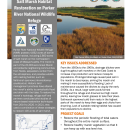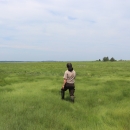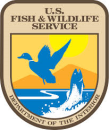Location













States
MassachusettsEcosystem
WetlandIntroduction
Parker River National Wildlife Refuge (NWR) preserves 4,662 acres of barrier island habitat along the northeastern shores of Massachusetts. Approximately 2,660 acres of the refuge is part of the Great Marsh, New England’s largest salt marsh salt marsh
Salt marshes are found in tidal areas near the coast, where freshwater mixes with saltwater.
Learn more about salt marsh ecosystem. The 20,000-acre Great Marsh provides important ecosystem services to neighboring communities like protection from storm surges, flooding, and erosion by reducing wave energy. The marsh’s peat soil stores 4,000 years worth of sequestered carbon dioxide from the atmosphere (Watson et al., 2017).
Saltmarsh sparrows (Ammodramus caudacutus) are an at-risk bird species that are only able to breed in Northeastern salt marshes, including the Great Marsh.
In unaltered systems, salt marshes regularly flood and drain with the tides. Periodic flooding sustains marsh vegetation and brings new sediment to the marsh, increasing its elevation enough to keep up with sea level rise. However, a series of historic land management practices have altered the natural hydrology of the marsh. From the 1600s to the 1900s, high density drainage networks and berms were constructed to increase crop production and reduce mosquito populations. Lack of maintenance caused these drainage ditches to clog up over time, increasing water retention in the marsh. Ultimately, this infrastructure and increased flooding due to storm surge have led to marsh subsidence, vegetation shifts, and shifts in wildlife use at Parker River NWR.
From 2014 to 2020, refuge staff and partners conducted a series of pilot studies to determine if nature-based restoration techniques could restore the natural function of the marsh. In 2021, refuge staff combined the most effective strategies to restore 100 acres of salt marsh on the refuge. These strategies included digging runnels to drain standing water and restore flow paths, adding hay to ditches to rebuild peat and reduce ditch density, and using dredged material to create nesting habitat for the saltmarsh sparrow. Another project to restore 1,450 acres of salt marsh is expected to begin in 2024. The U.S. Fish and Wildlife Service has identified nature-based solutions as a key strategy in its Climate Change Action Program to unify its climate response in accordance with the Department of the Interior’s Nature Based Solutions Policy.
Key Issues Addressed
Throughout the 17th and 18th century, drainage ditches were dug extensively in salt marshes across New England to increase production of salt marsh hay (Spartina patens) (Adamowicz et al., 2020). In the 1900s, these efforts were replicated to prevent mosquitoes from breeding in marsh waters (Riepe, 2010). Prolonged drainage caused the marsh’s peat soil to decompose and release carbon dioxide into the atmosphere, sinking the marsh over time. When marshes lose elevation, they become more susceptible to flooding.
By the early 2000s, the ditches had clogged up due to lack of maintenance, causing large water pools to form throughout the refuge. Algal blooms proliferated in these pools and killed off native marsh plants. Sustained flooding in these pools and the edge of marsh caused high marsh vegetation to drown, leaving low marsh grasses to take its place. Although both plants are vital to marsh ecosystems, high marsh vegetation provides irreplaceable wildlife habitat and flood protection benefits. Flooding in the marsh has and will continue to worsen as sea level rise increases over time.
These changes have huge implications for the marsh’s native wildlife. For example, although saltmarsh sparrows inhabit the entire East Coast of the US, they are only able to breed in salt marshes from Virginia to Maine. They tend to nest in the highest parts of the marsh, to protect their chicks and eggs from drowning. Loss of suitable nesting habitat due to increased flooding has led to a population decline of 87% since 1998, prompting the U.S. Fish and Wildlife Service to review its conservation status in 2024 (U.S. Fish & Wildlife Service, Saltmarsh Sparrow). Future efforts to support the saltmarsh sparrow will require slowing down the pace of marsh loss and restoring its breeding habitat.
Project Goals
- Restore the daily flooding and ebbing of tidal waters throughout the entire marsh surface.
- Restore healthy marsh vegetation that will help the marsh to keep pace with sea level rise.
- Reduce the decline of saltmarsh sparrow populations and increase nesting success for the saltmarsh sparrow.
- Increase the ability of salt marshes to mitigate storm damage and flooding to adjacent communities.
Project Highlights
- Digging Runnels: Runnels are shallow channels that help drain pools of standing water. In 2015 during the pilot study, scientists dug two runnels to drain a 3.52 hectare pool. By 2019, about 60% of the pool had been drained (Pau, 2022). From 2018 to 2021, low marsh grass cover in the pool was reduced by half and was largely replaced by high marsh vegetation (McKown et al., 2023). Between 2020 and 2021, staff created 23 additional runnels on the refuge.
- Healing Ditches with Hay: During the pilot study from 2014-2017, scientists studied the effects of adding bundles of native salt marsh hay to 17 ditches on the refuge. This process, known as ditch remediation, encourages peat soil development and subsequent vegetation growth. By 2017, the remediated ditches had shown an average increase in elevation of 15 cm. Salt marsh grass is able to grow in treated ditches that have become shallower than <15 cm (Burdick et al., 2017). In 2022, refuge staff remediated 30 additional ditch segments across the refuge.
- Removing Ditch Plugs: Ditch plugs are small dams made of soil designed to prevent water from flowing out of drainage ditches. During the pilot study from 2015-2020, staff removed ditch plugs from 12 sites to increase drainage on the refuge. After removal, the percent of time the sites were inundated dropped from an average of 94% to just 18% (Stuntz, 2021). In 2017, two ditch plugs were removed from an area that was largely dominated by low marsh vegetation (Spartina alterniflora) and bare ground. By 2022, the most abundant type of vegetation in the area was a high marsh species (Spartina patens).
- Creating Saltmarsh Sparrow Habitat: In 2021, staff used the sediment excavated while digging runnels and removing ditch plugs as natural infrastructure to create 60 microtopography islands. These islands increase marsh elevation and provide saltmarsh sparrows with more nesting grounds. By 2022, all islands exhibited 80 to 100% native vegetation cover, with three quarters primarily growing high marsh vegetation (DiNunzio et al., 2023).
Lessons Learned
Restoration Partnerships: Refuge staff worked with academics and private contractors to design and plan the restoration. Specialized equipment from the local mosquito control district was used in the pilot project.
State regulators want to be sure that hydrologic restoration projects do not have unforeseen long term impacts to the ecosystem. Promising results from the pilot studies gave the Massachusetts Office of Coastal Zone Management (CZM) and Department of Environmental Protection (MassDEP) the confidence to permit restoration projects along 100 acres of Parker River NWR. Based on this success, in April 2024 refuge staff and partners received a permit from MassDEP to conduct restoration projects along an additional 1,450 acres of the refuge. Due to the large-scale impact of these projects, staff found it beneficial to start conversations with regulators early.
The pilot studies also encouraged other conservation partners to take action. In 2020, The Trustees of Reservations primarily used ditch remediation to restore 85 acres of the Great Marsh (Trustees, 2023). The following year, they were granted $1 million to restore 1,274 additional acres of salt marsh. A portion of the land belongs to other conservation partners, including Essex County Greenbelt and the Massachusetts Division of Fisheries and Wildlife (Trustees, 2021). Working together has allowed refuge staff and their partners to plan projects that work best for the ecosystem without focusing on land ownership boundaries.
In addition to their pilot studies, refuge staff also monitored the effects of a 2018 Nor’easter that deposited large volumes of sediment on salt marshes across New England. Within 6 to 18 months, vegetation and benthic organism abundance fully recovered (Wittyngham et al., 2022). Marsh platforms near channels with deeper soil drainage were found to recover more easily from thicker sediment deposits. Desert saltgrass (Distichlis spicata) was more prominent within the first year of deposition, likely because it can tolerate waterlogged conditions. As more roots and organic matter grew in the sediment, S.patens outnumbered D. spicata (Nordio & Fagherazzi, 2023). Data gathered from this event can be used to develop future restoration efforts, particularly thin layer deposition (TLD) projects. TLD is a restoration technique in which dredged material is applied to the marsh’s surface to increase elevation.
Next Steps
- Restore 1,450 acres of Parker River NWR from 2024 to 2027, forming New England’s largest marsh restoration effort to date
- Work with the Saltmarsh Habitat Avian Research Program (SHARP) to determine whether restoration strategies are effectively increasing saltmarsh sparrow productivity
- Integrate monitoring from pilot projects and 100-acre marsh restoration to accelerate learning and reduce monitoring intensity for future projects: Synthesize results for a variety of audiences, including regulators, funders, and community members, to garner support for future projects
- Monitor whole marsh hydrology and elevation to better understand the holistic benefits of combining restoration techniques and whether the projects are improving the marsh’s ability to adapt to future climate stressors
- Continue to monitor natural adaptive events, such as pool breaching, natural ditch remediation, and ice rafted sediment deposition to refine future projects
- Work with academics and regulators to use mathematical models and remote sensing data to identify technologies that will quantify and standardize restoration design
- Implement nature-based solution restoration techniques throughout 8,000 acres of the Great Marsh on refuge and partner lands within the next 10 years: Utilize lessons learned in logistics, contracting, and quality control to help partner organizations implement similarly scaled projects and facilitate permitting
Funding Partners
Resources
- Burdick et al. (2017). “Innovative salt marsh restoration techniques for the Great Marsh.” Technical Report to the Parker River and Rachel Carson National Wildlife Refuges. 87pp.
- DiNunzio, et al. (2023). “100-acre Marsh Restoration at Parker River NWR.” Monitoring Report. U.S. Fish and Wildlife Service. Newburyport, MA.
- Nordio G, Fagherazzi S. (2023). “Recovery of salt marsh vegetation after ice-rafting.” Marine Ecological Progress Series 710:57-70.
- McKown et al. (2023). “Runnels Reverse Mega-pool Expansion and Improve Marsh Resiliency in the Great Marsh, Massachusetts (USA).” Wetlands 43, 35.
- Pau et al. (2022). “Salt marsh restoration techniques and research at Parker River National Wildlife Refuge.” National Wildlife Refuge System. U.S. Fish and Wildlife Service, Northeast Region. Newburyport, MA.
- Riepe, D. (2010). “Open marsh water management: Impacts on tidal wetlands.” Memoirs of the Torrey Botanical Society, 26, 80-101.
- Stuntz, L. (2021). “A Quick Overview of Marsh Restoration Water Levels.” Newburyport, MA.
- Trustees. (2021, April 26). $1m grant quadruples Trustees salt marsh restoration work.
- Trustees. (2023, April 6). Resilience at Old Town Hill.
- U.S. Fish & Wildlife Service. (n.d.). Saltmarsh Sparrow.
- Watson et al. (2017). “Anthropocene survival of southern New England's salt marshes. Estuaries Coast.” Estuaries Coast 40(3):617-625.
- Wittyngham et al. (2022). “Biotic Recovery Following Ice-Rafting in a Salt Marsh.” Estuaries and Coasts 45, 1361–1370.
- Description and Project Design for 1450 Project
Contact
Nancy Pau, Wildlife Biologist, Parker River NWR: nancy_pau@fws.gov
CART Lead Author
Belen Delgado Mio, Case Study Author, USFWS Maintenance and Infrastructure Fellows Program
Suggested Citation
Delgado Mio, B. and Pau, N. (2024). “Salt Marsh Habitat Restoration on Parker River National Wildlife Refuge” CART. Retrieved from https://www.fws.gov/project/nature-based-solutions-salt-marsh-habitat-restoration









